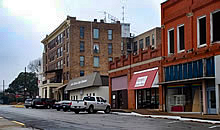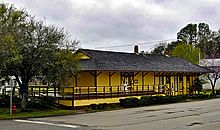Main Menu
Anderson County Data
Anderson County Communities & Places
Genealogy & History Links by USGHN
Important Anderson County Addresses
Sponsors
Anderson County Neighbors
Cherokee County, Texas
Freestone County, Texas
Henderson County, Texas
Houston County, Texas
Leon County, Texas
Navarro County, Texas
Other Websites
Welcome to Anderson County Texas Genealogy & History Network!
Welcome to the Anderson County, Texas Genealogy & History Network. Our purpose is to provide visitors with free resources for genealogical and historical research. To share your genealogy or history information, send an email to txghn@outlook.com and we will happily include it here. For other Texas Counties, visit the Texas Genealogy & History Network state website and go to the appropriate county. Thanks for visiting and good luck with your research! |
|
About Anderson County, Texas...

Indians friendly to the settlers resided in east Texas before the Kiowa, Kickapoo, Kichai, Apache and Comanche intruded upon their territory. These tribes hunted, farmed the land, and were adept traders. By 1772 they had settled on the Brazos at Waco and on the Trinity upstream from the site of present Palestine. The Tawakoni branch of Wichita Indians originated north of Texas, but migrated south into east Texas. From 1843 onward, the Tawakoni were part of treaties made by both the Republic of Texas and the United States.
On May 19, 1836 an alliance of Comanche, Kiowa, Caddo and Wichita attacked Fort Parker, killing or kidnapping all but about 18 settlers who managed to escape to Fort Houston, which had been erected in Anderson County in 1835 as protection against Indians. Among the captured was Cynthia Ann Parker, who later became mother of Comanche Chief Quanah Parker. Some residents of Anderson County are  related to Cynthia Ann Parker.
related to Cynthia Ann Parker.
In October 1838, Gen. Thomas Jefferson Rusk conducted a raid against hostile Indians at Kickapoo, near Frankston, ending the engagements with the Indians in eastern Texas for that year.
In 1826, empresario David G. Burnet received a grant from the Coahuila y Tejas legislature to settle 300 families in what is now Anderson County. Most of the settlers in the county came from the southern states and from Missouri.
Baptist spiritual leader Daniel Parker and eight other men organized the Pilgrim Predestinarian Regular Baptist Church in Lamotte, Illinois. The fellowship in its entirety migrated in 1833 to the new frontier of Texas. Among this group of settlers were Silas M. Parker, Moses Herrin, Elisha Anglin, Luther T. M. Plummer, David Faulkenberry, Joshua Hadley, and Samuel Frost. Fort Parker was the earliest actual  settlement in the vicinity. After the fort was attacked, some of the survivors moved to Anderson County.
settlement in the vicinity. After the fort was attacked, some of the survivors moved to Anderson County.
The First Legislature of the state of Texas formed Anderson County from Houston County on March 24, 1846. The county was named after Kenneth Lewis Anderson. Palestine was named county seat.
Anderson County voted in favor of secession from the Union. When the Civil War broke out, former Palestine district judge Judge John H. Reagan served in the cabinet of the Confederate government as postmaster general, being captured at the end of the war and spending twenty-two months in solitary confinement. During Reconstruction, District Nine Court Judge Reuben A. Reeves, a resident of Palestine, was removed from office as "an obstruction to Reconstruction" in part because of his refusal to allow  blacks to participate as jurors in the judicial process.
blacks to participate as jurors in the judicial process.
In 1875, the International – Great Northern Railroad placed its machine and repair shops and general offices in Palestine, causing the community to double in size over the next five years.
In January 1928 the first successful oil producer in Anderson County, known as the Humble-Lizzie Smith No. 1, was brought in. By the year 2000 - 295,904,540 barrels (47,045,062 m3) of oil had been taken from county lands since 1929.
The Gus Engeling Wildlife Management Area was purchased by the state between 1950 and 1960, much of it from Milze L. Derden. The area was renamed in 1952 after Gus A. Engeling, the first biologist assigned to the area, was shot and killed by a poacher on December 13, 1951.
 The county has a total area of 1,078 square miles, of which 1,063 square miles is land and 15 square miles (1.4%) is water. The population recorded in the 1850 Federal Census was 2,684. The 2010 census recorded 58,458 residents in the county.
The county has a total area of 1,078 square miles, of which 1,063 square miles is land and 15 square miles (1.4%) is water. The population recorded in the 1850 Federal Census was 2,684. The 2010 census recorded 58,458 residents in the county.
Neighboring counties are Henderson County (north), Cherokee County (east), Houston County (south), Leon County (southwest), and Freestone County (west). Other communities in the county include Palestine, Elkhart, Frankston, Bois d'Arc, Bradford, Broom City, Cayuga, Long Lake, Montalba, Neches, Pert, Slocum, Tennessee Colony, and Wild Cat Bluff.
Anderson County, Texas Records
Birth Records - The Texas Department of State Health Services has records from 1903 to present. Records for the last 75 years considered private and will only be provided to certain individuals. To obtain current information on who may obtain a record, how to submit a request and an official request form, see the Texas Department of State Health Services website or write to Texas Vital Records, Department of State Health Services, P.O. Box 12040, Austin, TX 78711-2040.
For older birth records you will have to write to the County Clerk of the applicable county. The existence of birth records prior to 1903 will vary widely from county to county. Local historical societies and genealogy collections in local libraries may be able to provide some information.
Death Records - The Texas Department of State Health Services has records from 1903 to present. Records for the last 25 years considered private and will only be provided to certain individuals. To obtain current information on who may obtain a record, how to submit a request and an official request form, see the Texas Department of State Health Services website or write to Texas Vital Records, Department of State Health Services, P.O. Box 12040, Austin, TX 78711-2040.
Marriage Records - The Texas Department of State Health Services can provide a verification letter of marriage for Texas marriages from 1966 to present. This is NOT a marriage license. To obtain a certified copy of a marriage license you must contact the County or District Clerk in the county or district where the marriage took place.
Local historical societies and genealogy collections in local libraries may be able to provide some information.
Divorce Records - The Texas Department of State Health Services can provide a verification letter of divorce for Texas divorces from 1968 to present. This is NOT a copy of the divorce decree. To obtain a certified copy of a copy of the divorce decree you must contact the County or District Clerk in the county or district where the divorce took place.
Local historical societies and genealogy collections in local libraries may be able to provide some information.




